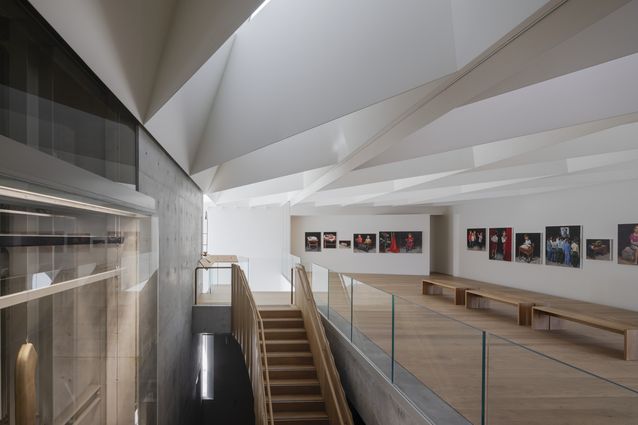
This article is part of our latest design special report on creative people finding new ways to interpret ideas from the past. When Joyce Poulson was awakened by her fire alarm in the early morning of November 12, 2018, she saw no flames or smell of smoke. She went upstairs to her butterfly house in the Silver Lake neighborhood of Los Angeles to try to turn off the alarm and called the alarm company. She said. “I had to walk past it to get to the door. I don’t know how my nightgown didn’t catch fire. ”At sunrise it was clear that her 1,640-square-meter timber frame house had burned down to the tunnel because of a wandering embers trapped invisibly between them, the chimney and wall. Your insurance company would soon label the historically significant building a total loss. Today the 69 year old house, which was originally designed by Ain, Johnson and Day for artist and educator Marjorie M. Greene, looks so fresh it did in 1952. It was designed by Escher GuneWardena Architecture thanks to archive research, preservation of the remaining structure and Forensic reconstruction of the plans was carefully restored, as even the original plans, which were kept in a cupboard in the basement, were burned. A week or two after the fire, Ms. Poulson, 78, contacted the firm’s partners, Frank Escher and Ravi GuneWardena, at the suggestion of a neighbor who knew Mr. GuneWardena from studying abroad and asked them to rebuild it by not selecting more zealous and experienced architects to have. The 25-year-old company also helped to preserve the Eames House and the restoration and redesign of the Chemosphere House by John Lautner. Though less known than Lautner or Charles and Ray Eames, Gregory Ain (1908-1988), one of the main designers of the house, was an integral part of the Los Angeles modernist movement and American architects’ search for inexpensive, innovative and flexible living space for the masses . Named Los Angeles’ first modernist historic district in 2003, his Mar Vista Tract, also designed with Joseph Johnson and Alfred Day and completed in 1948, could create a diverse and charming neighborhood. Ain’s firm followed with Community Homes, a racially integrated cooperative for 280 families, including that of landscape architect Garrett Eckbo (a friend and frequent collaborator) and singer and actress Lena Horne, but couldn’t get government funding. Ain and Eckbo, both socialists, decided to let the project die instead of running it as a suburb for whites only. The California Senate Committee of Inquiry into Un-American Activities later declared Ain a “more notorious critic of the committee.” Poulson, a retired computer software saleswoman, began a love affair with modern architecture long before 1988 when she bought the Greene house, which she was only the third owner of. In the early 1960s she rented one of the apartments behind the studio of the architect Richard Neutra (Ain worked for Neutra in the 1930s). In the 1980s she lived in the guest house of the Neutra VDL House, where she attended classical music concerts with the architect’s widow, the musician Dione Neutra. “Every time she started describing something, she was very emotional,” said Mr. GuneWardena of his first conversations with Ms. Poulson. “She said it was Gregory Ain’s house, it was in a magazine she had, but it was in the house. Several times she said: ‘I’ll show you the photos’, then remembered that the photos were burned. ”They made an appointment at the skeleton of the house. The designers “immediately noticed that this was an important building and said, ‘Don’t tear anything off,’” recalls GuneWardena. One of their first jobs was to prove that the Greene house was indeed from Ain, a necessary step if you were to add the house to HistoricPlacesLA, a conservation database, and apply the city’s conservation codes to the restoration. The building permit only named Johnson and Day, Ain’s former partners, as did the plans in the Eckbo archives of the University of California, Berkeley. But the Ain Archives at the University of California, Santa Barbara, had a folder of unidentified projects, and there, lo and behold, they found two presentation drawings that said, “Marjorie Greene, 1952”. Rereading a chapter on Ain in Esther McCoy’s Second Generation, a 1984 book about California architects, Mr. Escher and Mr. GuneWardena noticed a reference to a unique, unpictured Ain house with a butterfly roof, just like the Greene House. Sasha Plotnikova, the project manager for the research phase of the house, also noted that the plan was very similar to one of Ain’s most famous works, the 1950 Exhibition House for the Museum of Modern Art, which was meant to be a demonstration of a skill in subdividing the house with a high quality, modern design – a corrective to the traditional, box-shaped forms of the emerging Levittowns. (Until recently, the Ain house was long considered a lost design by MoMA. Christiane Robbins and Katherine Lambert, filmmaker and architect who have been researching for Ain for more than a decade and sharing parts of their ongoing documentary, had MoMA to document the Asked house and received only a thin file.-based historian who founded and runs the USModernist nonprofit discovered the house survived, auctioned, and reassembled in Croton-on-Hudson, NY, where a family named Kelly has been since 1979 lives in it.) The Los Angeles Version is now on record as a sibling. “This house is super site-specific,” on a hill, and not in one of the flat suburbs Ain wanted to reform, said Anthony S. Denzer, professor of architectural engineering at the University of Wyoming and author of “Gregory Ain: The Modern Home As Society Commentary “(2008). “It seems to me that Marjorie Greene probably came to Ain because she saw the MoMA house and said, ‘I really like this,’ but then he made it fit the website.” Greene herself had an architectural pedigree: she was the niece of prolific Pasadena architects Greene & Greene. said Herr Denzer. This would likely have required the addition of massive shear walls within the two story glass wall overlooking Silver Lake, which would have radically changed the open look of the home. (A new code that applies: sprinklers.) “I can say with confidence that he designed the house,” said Mr. Denzer, but he doesn’t know why Ain didn’t include it in his own archive. Ain’s penchant for perfecting one detail and then using it in one project after another proved practical as the designers could look for window or furniture details on his other buildings from the same era. Escher and Mr. GuneWardena estimated that in the end 50 percent of the house’s original materials were retained, including the butterfly roof edging, parts of the sub-floor and floor structure, the brick chimneys, and almost all of the concrete. Most of it is covered over, with new birch plywood furniture, new cork tiles, and new plaster over wooden frames that are sometimes original, sometimes replaced, and sometimes welded – new elements tied to the old ones with nails or screws for strength 18 months and was completed in April. Ms. Poulson’s favorite places in the house remain the same: the corner where she can read in her Eames lounge chair and look out over Silver Lake; and the highly efficient kitchen, where you can get to the sink, stove and pantry in just a few steps. “It’s nice to be in the living room and be able to look into this kitchen area – it’s like a long extension of itself,” she said. “Although there are houses on either side of me, I don’t hear or see anything but the lake and mine Garden. “The scorch marks are only visible in two places. You can see it out in the open where the string has been scraped off and its newly ragged ends sealed on a built-in pentagonal table designed by Eckbo.” Now it’s like something that George Nakashima designed “with a free edge,” because of the burning, “said Mr. GuneWardena. Delia Hitz, a garden designer, has updated Eckbo’s beds with intact edges and all the native plants that should need less water. And there is damage inside at the scene of the accident (barely) visible: you could see the chimneys, “said Ms. Poulson.” You had to clean them to put the brick back on the brick, but there is smoke damage i in the chimneys where it’s black. ”She said she would never light a flame there again. Other than those remains, the house looks and feels the same as it did when you moved in, she said. “I don’t know how you did it.” She is grateful to be back after her time in exile over the Americana at Brand complex: “It had a lot of bling for me, a lot of people, everything was too much,” she said. Poulson also appreciates how the rebuilding process taught her so much about the house, “including Gregory Ain and other architects,” she said. “I love my house more now than it did before the fire – it means so much more to me now.”
[ad_2]











